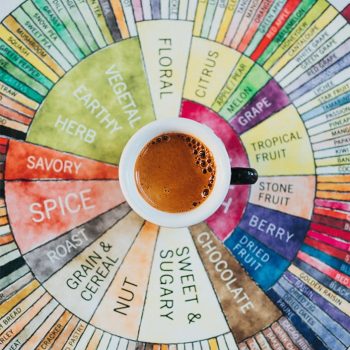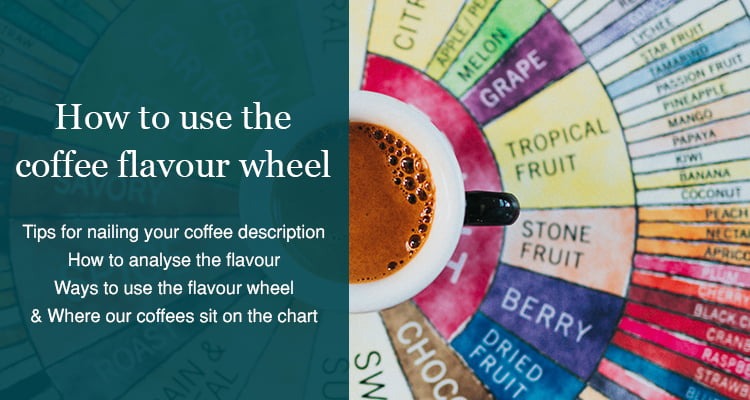

After reading this guide you will know exactly how to describe your coffee flavours using the iconic flavour wheel.
We are going to give you the best tips for analysing flavour profiles and give you a breakdown of how the professionals do it (it’s much simpler than you might think!).
At the end of the guide you will find examples of where our most popular coffees sit on the chart to consolidate your new-found knowledge.
But first, here’s what determines the flavour of your cup…
How to describe coffee and tips for analysing the flavours
Many of us think the same thing when we’re attempting to describe the flavours of coffee…
‘Where do I start? It just tastes like… coffee?’
If you’re new to this, we don’t blame you. It takes a little practice to nail the art of describing coffee flavours.
The most difficult part is that there are so many complex aspects to our favourite drink. So, first we need to cover the basics. Here are the 8 factors that contribute to the final taste of your cup:
1. Origin
Where it all begins, the origin of the beans. The location of where your beans are grown and harvested has a big impact on the flavours of the coffee.
Every origin has its own unique conditions, and as these vary, so does the taste. The varying growing characteristics of different origins could include:
- Soil acidity
- Climate
- Temperature
- Elevation
- Harvesting process
- Handling process
- Surrounding agriculture
For example, Guatemalan blends are known for their rich body and sweet flavours, whereas Brazilian beans are favoured for their creaminess and chocolatey taste.
Take a look at our single origin flavour chart for a full break down of 24 coffee origins.
![]()
2. Roast
Once the beans have been harvested and processed, they get sent over to us for roasting.
This step has a huge impact on flavour and can make or break a coffee. Roasting is for enhancing the beans and bringing out the varying flavours.
Under roasting can lead to a lack of flavour and over roasting can cause bitter acrid notes.
Roasts vary from light, medium and dark, and each blend requires its own profile of roasting to achieve the best taste. There can also be levels in between these three roasts, such as light – medium or medium – dark.
It is recommended to hand roast in small batches to ensure a perfectly even and high-quality batch.
![]()
3. Fragrance
Fragrance is the smell of grounds, pre-brewing.
If you don’t take a whiff of your fresh bag of coffee before brewing, you’re missing out.
Smelling the fragrance of grounds is a big part of detecting the flavours. It is also interesting to see how brewing affects the smell of your coffee.
![]()
4. Aroma
This is the smell of your coffee during or post-brewing.
You may hear a lot of talk about coffee aroma as so many fanatics swoon and boast about the aroma of their cup. But, we highly recommend you give your kitchen a good sniff during brewing to fully evaluate the aroma.
At first you just smell coffee, but once you pay attention and try different blends, coffees and origins, you will soon notice the difference in aromas and be able to describe the scent.
![]()
5. Acidity
There are many different acids found in coffee, such as quinic, acetic, tartaric, chlorogenic, malic, citric and phosphoric acid.
Acidity is usually a positive way to describe a cup of coffee and many drinkers look for this in their beans. It can bring vibrance to a coffee and help the flavours stand out even more.
Some acidities may start off bold and finish smooth or pack a bold punch right from the get go.
Read our guide to acidity in coffee for a detailed breakdown and the tastiest low acid blends.
![]()
6. Flavour
Flavour; the star of the show. What we’re all looking for in our cup.
This is the overall impression of the cup, considering all these contributing factors. It is the distinctive taste you get from your coffee when drinking it.
Flavour profile is usually the most important factor for the majority of coffee drinkers and is the first thing they look for when purchasing beans, which is understandable as most drink coffee for the delicious flavour.
![]()
7. Body
Also known as ‘mouthfeel’. It is the weight and texture of how coffee feels in the mouth.
You probably don’t notice the body of your drink in everyday life, but it can be analysed by swishing the coffee around in your mouth and paying attention to how it feels.
Some compare it to the varieties of milk, such as skimmed, semi-skimmed, full fat etc. Some are heavier, thicker and creamier, which is how the body of coffee can taste.
![]()
8. Aftertaste
Have you ever taken a sip, put down your cup and then been surprised by the change of flavour in your mouth?
This is called the aftertaste, also known as the ‘finish’.
Lots of coffees have a very different aftertaste to the flavour you first experience when taking a sip. The aftertaste can linger for hours after you’ve had a cup of coffee and is produced by the many gases present in grounds.
Now you know where the flavour comes from, here are some tips for evaluating the taste…
![]()
Tips for coffee tasting
Analysing coffee is intimidating at first and you may not see the use of it. But, when you nail the flavours of your favourite coffee and create a perfect description, it is a pretty fulfilling feeling.
It is also super helpful when trying new coffees, as you will become familiar with the characteristics you do and don’t like.
Here are a few tips to get you started:
- Write. Down. Everything. – And we mean everything. Even if you don’t think it’s useful, just jot it down. For example, the first sip may remind you of Werther’s Originals. Then when you look back over your notes and analyse further, you come to realise it is actually a ‘delicate toffee aroma’.
- Find a quiet area with no conflicting smells. Analysing coffee is not an easy task, especially for newcomers. A busy environment with other strong smells is too distracting and may sabotage your evaluation.
- Ask yourself questions. If you don’t like the flavour, don’t stop there. Ask yourself, ‘Why don’t I like it?’. If the answer is you don’t like the acidity, for example, dig deeper and ask yourself ‘Is the acidity too sharp? Is it too bright? Or, is it too mild?’
- Immerse your senses. It’s not just about tasting a cup of coffee. To get an accurate description, you need to pay your full attention to every step of the process, including preparation and brewing. Feel the coarseness of the grounds, watch how they soak up the water and smell the aroma that takes over your kitchen.
- Get inspired through research. If you’re struggling with terminology and need some description inspiration, do some research and see how other people are describing their coffee. We include the flavour profile on all our products, have a browse here.
Keep reading to find out how the flavour wheel works and the simple steps to using it in your evaluation…
How to use the flavour wheel
The coffee flavour wheel is an iconic educational chart that was created by the Speciality Coffee Association (SCA). It is based on the World Coffee Research Sensory Lexicon, which is a 54 page booklet that goes into more depth of coffee flavours than you can imagine.
That’s not to say the wheel is any less complicated, as that alone has over 70 different flavour varietals.
Once you know how to navigate it, the flavour wheel is an incredibly useful asset to your coffee analysis. Here are some easy tips to get you started:
Tip #1
Familiarise yourself with the wheel. As it’s such an in-depth resource, it is easy to miss certain aspects and skim past them.
Thoroughly read through each section to become accustomed to the vast terminology. This will be much easier when you’re faced with a cup of coffee and are trying to quickly scan through to interpret the flavours.
Tip #2
Start from the middle and work your way outwards. The wheel starts vague, with general flavour groups and gets more specific as you work your way towards the outer edge.
So, start with a general taste, such as fruity. Hone in on this and decide what type of fruit, maybe berry fruit. Compare the characteristics of different berry fruits and try categorising the flavour you’re experiencing, which could be blackberry.
Tip #3
The colours are there to help. At first, they may seem unnecessarily distracting, but pay closer attention and you will notice that they actually aid you in your analysis.
Our brains associate colour with taste. Each colour on the wheel is has been specifically chosen to represent that taste, which subconsciously makes it easier to navigate the wheel.
Tip #4
Use it for casual drinking. Although it may look pretty advanced, you can use this chart however you like. Some use it for professional cupping, although start by simply using it for a casual cup of coffee.
Take a few sips and have a quick browse of the chart to see if you can pinpoint the flavours. No pressure, just for fun. As you get more practice, you can become more serious in your evaluation.
Tip #5
Use this interactive wheel. This guide allows you to click on each section and view an example of what the flavour would smell like.
This is very useful for the unusual descriptions on the wheel such as ‘hay-like’, which apparently smells like parsley flakes.
It is also a great guide for when you’re buying online. If a blend has been described as ‘winey’, the wheel will tell you that this equates to the aroma of Yellow Tail Cabernet Sauvignon.
To consolidate your knowledge, here are some examples of where our coffees sit on the chart…
Coffee flavour wheel explained – where various blends sit on the chart
We’ve given you the tools and knowledge to get started on your flavour analysis adventure.
If you need a little more guidance, here are where some of our favourite blends sit on the chart…

The prestigious Jamaican Blue Mountain is one of the finest cups of coffee in the world. Its flavour profile includes a delicate floral aroma paired with a clean and pure taste. The medium to low acidity is complimented well by the soothing light body.

These Ethiopian are bursting with flavours of blueberry fruit and delicate lemon zest. It is a bold coffee that is favoured for its bright acidity and depth. Here’s what one customer thought:
“Agree this is one of the best. Bold, fruity and lots of depth. I brew this using a stove top pot. Having recently returned from a trip to Ethiopia, where every coffee I had was outstanding, I was keen to find an ‘authentic’ coffee here. This is it!”
These East African ones have an intense flavour profile of pungent spice. We roast this coffee at a high level to intensify the depth of the dark characteristics.
When tasting, you will notice a low acidity paired with a rich aftertaste.

This single origin Mexican coffee benefits from a delicious flavour profile of nut, dark sugar and cinnamon. This is perfectly balance by the medium/high acidity and is a great option for those who don’t want their drink too sweet.

